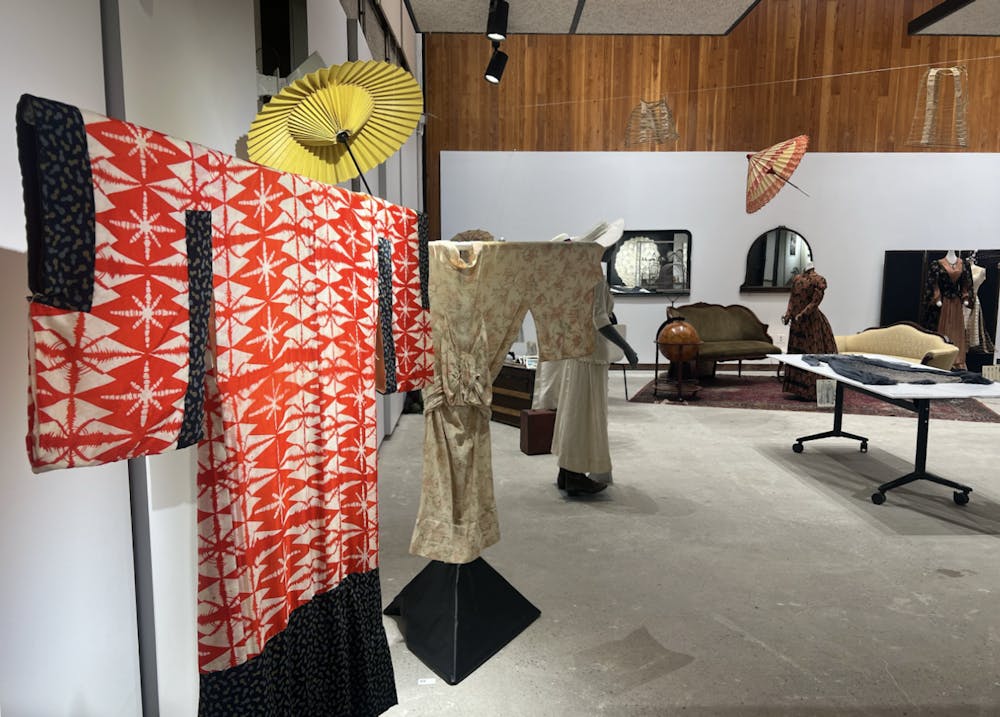This month saw the first exhibition of the Middlebury College Antique Clothing Collection. Titled “Gathering and Uncoupling: An Exhibit of Historic Clothing and Contemporary Photography,” the exhibit in the Johnson Exhibition Gallery of the recently renovated Johnson Memorial Building transports its visitors through generations of Middlebury’s past residents.
Visiting Assistant Professor of Theatre Summer Jack, who joined the faculty last year, inherited Middlebury’s historic clothing collection when she assumed her new position. Jack curated the “Gathering and Uncoupling” exhibit alongside Colin Boyd, director of the Johnson Memorial Building and manager of the Johnson Gallery.
The collection, which consists mainly of garments dating from 1830 to 1920, contains roughly 400–500 documented items and hundreds more undocumented items. It is entirely made up of clothing donated by local residents who trusted the college with their old garments. Some of the pieces have been used in past Middlebury Theatre performances and still serve as inspiration for theatre costume designers when designing costumes for current productions.
Because they are garments that real people wore and cherished, many articles in the collection display clear signs of wear and tear, including sweat-stains and splashes of stage blood.
“It’s living history,” Jack said in reference to the liveliness these elements add to the exhibit.
Because the pieces were given to the college without detailed records of who donated what, Jack said that doing investigative work, or “reading a dress,” as she described it, is a large part of her work. While it is often impossible to discern the exact dates of pieces, Jack explained that she can make an approximation by analyzing the shape, silhouette, fabrics and stitching. This process can be difficult because styles used to remain popular for a much longer period than they do in today’s rapid trend cycle.
In an effort to give viewers more context, the exhibit features signs that note the time period each article of clothing is likely from. The signs are made out of old fashion catalogs, providing the audience with even more examples of eighteenth and nineteenth-century fashion.
Some pieces in the collection hold special significance to the college’s history, such as a black silk satin mantle from the 1890s, often called an “Opera Cape.” The cape’s handwritten tag lists Alice Brainerd, the daughter of late nineteenth century Middlebury College President Ezra Brainerd, as the garment’s original owner.
Not only does the exhibit showcase an underappreciated asset of the Middlebury Theatre Department, but it also creates an opportunity for art students to practice drawing intricate patterns and unique textures. When selecting which pieces to display from the extensive collection, Jack and Boyd paid special attention to pieces with eye-catching ornamentation that students would enjoy drawing, such as the Battenburg lace hem of a tea dress, likely dating from between 1901 and 1904.
Pieces in the exhibit are displayed within thoughtfully designed sets that help describe how and why each outfit was worn. A women’s hunting dress meant to be worn side-saddle, for example, is displayed alongside a taxidermied deer head, colorful fake leaves and a statue of a hunting dog.
Additionally, Jack chose to feature various crinolines, garments intended to be worn under dresses to provide structure, both on mannequins and hanging from the ceiling, adding another spatial dimension to the exhibit. She opted to include the crinolines, along with other undergarments, to help viewers imagine how complicated and different it was to get dressed at the time.
The Middlebury College Antique Clothing Collection is not limited to just clothing, however. Many of the accessories featured in the exhibit demonstrate creativity and practicality. A Miser's purse, a fabric tube for coins meant to make women have more difficulty accessing their change as a way of self-limiting spending, stands out among the accessories on display. Another highlight is a pair of antique boots, which interestingly did not have distinct left and right shoes. Finally, mannequins vested in chic linen dusters and hats are complemented by 1930s motoring goggles.
In addition to the Antique Clothing Collection, the exhibit houses Rob O’Neil’s entrancing photography series “Uncoupling,” O’Neil, a photographer and high school teacher currently based in Albany, N.Y. created the series using repurposed glass plate lantern slides from the 1910s and 1920s. The images are thoughtfully displayed throughout the walls of the exhibit, intended to create a back and forth interaction with the antique clothing, according to Jack.
“Each image represents a decontextualized world where disparate people, places and times co-exist,” read a quote by O’Neil on the plaque next to his pieces. O’Neil succeeds in creating this decontextualized world by layering silhouettes and contrasting backgrounds to create haunting and abstract images.
Looking forward, Jack said she hopes to improve the storage conditions of the Antique Clothing Collection. It is currently housed in the basement of the Wright Memorial Theatre, and while it was thankfully unaffected by this past summer’s floods, Middlebury’s frequent temperature fluctuations expedite the garments’ deterioration.
Jack is also aiming to garner more support from the college, which includes potentially hiring a conservator to help ensure the future security of the collection, as that area is not part of her expertise.
“Gathering and Uncoupling” will be on display until Jan. 5. Look out for more information about a potential spring exhibit of the Middlebury College Antique Clothing Collection focused on the theme of extinction.




